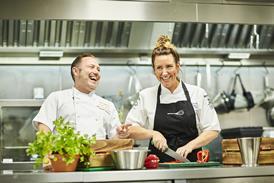
Publishing: 5 September
Advertising deadline: 19 August
Submissions deadline: 14 August
Contact: Emma Sturgess (emma-sturgess@hotmail.co.uk)
Bog standard tea and coffee won’t cut it anymore. As Brits trade up to premium offerings, such as coffee pods and artisan teas, mainstream brands are chasing them by launching more upmarket offerings, such as wholebean instant coffee and special blends or tea or fruit and herbal infusions. How successful have these efforts been? And with a number of mainstream tea brands launching premium but keenly priced premium ranges, is price competition set to hot up in posher tea?
Key themes:
Tea: Value has inched up but volumes are down. The feature will explore why tea continues to struggle. Black tea in particular continues to decline while the likes of green, fruit and herbal teas are booming. And what formats are rising in popularity? Has the tea pod gained any traction? What about loose leaf tea?
Commodity prices: Earlier this year, it was warned that fluctuating prices could prompt some suppliers to alter their tea blends. What’s the latest? Can we expect a shift in blends or will picky Brits stop that from happening? How have raw material costs impacted the performances of the category’s major players? How have price changes affected that paid by consumers?
Retailers: This feature will include in-depth analysis of how the different retailers’ approach to the hot beverages market. How are they merchandising it? How have their own label ranges developed in the past year? What’s on the cards for the coming year?
Pods: Pods have grown by 31.4%. It’s not just young affluent Londoners buying them either. Two thirds of this growth came from the Midlands and the North. What’s helped this growth percolate? How much have tea pods contributed to this? And just how big can the pods market get?
Coffee: Coffee sales are steaming ahead, driven by branded propositions. Who’s driving this growth and where is it coming from? Premium and super premium continue to perform well. What does this mean for brands not operating in this space?
Premiumisation: Super premium coffee has grown by 16% as consumers trade up to pricier offerings. What tactics have brands used to encourage consumers to buy more premium products? How much more are they paying per cup? What are they promising for the extra money?
Hot chocolate: The sub category is flying, driven by branded offerings lowering prices. This feature will explore which brands and retailers have been driving this growth and look at what these players are doing to sustain the sub category’s growth over the coming year. It will also investigate what is behind the drop in average price – are players going hard on promotions to generate sales?
Own label: The feature will pay close attention to the performance of own label over the past year. Its performance in some categories – in coffee and hot chocolate, for example – contrasts with branded. Why is this? What are own label players doing to recapture lost sales? Please pay close attention to individual retailer performance in this.
Discounters: The discounters and bargain stores are steaming ahead in hot beverages. So, what is behind their growth? What strategies have they employed to do this? Have they extended their own labels and which brands are they stocking?
Malt-based drinks: Malted drinks have gained some value this year, although volumes are still falling. An average price hike has helped drive this value growth, so what’s caused it? Premiumisation? Fewer promotions? Commodity prices?
Price/promotions: This feature will investigate how big a part price promotions have played in the market over the past year. It will explore how spend on this area has impacted brands’ spend on other areas such as advertising and NPD and how promotional mechanics employed have evolved and are likely to continue to evolve.
Advertising and marketing: This feature will also investigate how the marketing and advertising strategies of the category’s biggest players have evolved over the past year and how they will develop in the coming year to sustain growth or return brands to growth.
Innovation: Key to this feature will be a discussion of the latest NPD from the category’s brands and own label players, large and small. The feature will explore the market trends that have inspired these innovations and weigh up which new launches are most likely to encourage new trends in the hot beverages category.
Box-outs:
Innovations: 12 new products (four tea; four coffee; four hot choc/malted drinks) or product ranges that have not appeared in The Grocer before, including launch date and RSP, plus a picture of each.
Functional health claims: We look at the growing trend for brands to use functional health claims to market their products. Who’s doing this and for which products? What does the future hold in this area?
Global NPD: Tea insiders suggest the UK market for speciality tea has a long way to go pointing to the sophistication of the US market as an example of how things could develop. We look at examples of recent speciality teas launched in the US and other markets and ask how the UK market could develop.
Price: Sales of pods, super premium coffees and premium teas are increasing. But how much more are Brits paying for their favourite cuppa? How much does it cost for a standard, premium, super premium and pod coffee and tea?
Key questions the feature is likely to address:
- What consumer trends have impacted the category over the past year?
- How have promotional strategies (both in terms of price and marketing) evolved?
- How have individual retailers’ strategies impacted the market?
- How has merchandising changed in the market?
- What impact has own-label had on branded players?
- What’s next for the category?
- We profile four new products or product ranges that have ideally not appeared in The Grocer before, including launch date and RSP.
Downloads
Focus On Hot Beverages - brief
PDF, Size 0.29 mb
Source













No comments yet